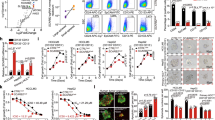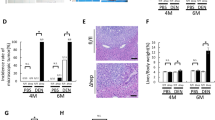Abstract
The expression of P-glycoprotein encoded by the multidrug resistance (MDR1) gene is associated with the emergence of the MDR phenotype in cancer cells. Human MDR1 and its rodent homolog mdr1a and mdr1b are frequently overexpressed in liver cancers. However, the underlying mechanisms are largely unknown. The hepatocarcinogen 2-acetylaminofluorene (2-AAF) efficiently activates rat mdr1b expression in cultured cells and in Fisher 344 rats. We recently reported that activation of rat mdr1b in cultured cells by 2-AAF involves a cis-activating element containing a NF-κB binding site located −167 to −158 of the rat mdr1b promoter. 2-AAF activates IκB kinase (IKK), resulting in degradation of IκBβ and activation of NF-κB. In this study, we report that 2-AAF could also activate the human MDR1 gene in human hepatoma and embryonic fibroblast 293 cells. Induction of MDR1 by AAF was mediated by DNA sequence located at −6092 which contains a NF-κB binding site. Treating hepatoma cells with 2-AAF activated phosphoinositide 3-kinase (PI3K) and its downstream effectors Rac1, and NAD(P)H oxidase. Transient transfection assays demonstrated that constitutively activated PI3K and Rac1 enhanced the activation of the MDR1 promoter by 2-AAF. Treatment of hepatoma cells with 2-AAF also activated another PI3K downstream effector Akt. Transfection of recombinant encoding a dominant activated Akt also enhanced the activation of MDR1 promoter activation by 2-AAF. These results demonstrated that 2-AAF up-regulates MDR1 expression is mediated by the multiple effectors of the PI3K signaling pathway.
This is a preview of subscription content, access via your institution
Access options
Subscribe to this journal
Receive 50 print issues and online access
$259.00 per year
only $5.18 per issue
Buy this article
- Purchase on Springer Link
- Instant access to full article PDF
Prices may be subject to local taxes which are calculated during checkout












Similar content being viewed by others
References
Alessi D, James SR, Downes CP, Holmes AB, Gaffney PR, Reese CB, Cohen P . 1997 Curr. Biol. 7: 261–269
Babio BM . 1999 Blood 93: 1464–1476
Bae YS, Sung JY, Kim OS, Kim YJ, Hur KC, Kazlauskas A, Rhee SG . 2000 J. Biol. Chem. 275: 10527–10531
Bae YS, Kang SW, Seo MS, Baines IC, Tekl E, Chock PB, Rhee SG . 1997 J. Biol. Chem. 272: 217–221
Bar-Sagi D, Hall A . 2000 Cell 103: 227–238
Benard V, Boh BP, Bokoch GM . 1999 J. Biol. Chem. 274: 13198–13204
Bishop A, Hall A . 2000 Biochem. J. 348: 241–255
Borst P . 1997 Cancer Biol. 8: 131–134
Chaudhary PM, Roninson IB . 1993 J. Natl. Cancer Inst. 85: 632–639
Chin KV, Tanaka S, Darlington G, Pastan I, Gottesman MM . 1990 J. Biol. Chem. 265: 221–226
Cieslik K, Abrams CB, Wu KK . 2001 J. Biol. Chem. 276: 1211–1219
Cornwell MM, Smith DE . 1993 J. Biol. Chem. 268: 15347–15350
Dame JE, Liu L, Rosten P, Humphries K, Jefferson AB, Majerus PW, Krystal G . 1996 Proc. Natl. Acad. Sci. USA 93: 1689–1693
De Mendez I, Garrett MC, Adams AG, Leto LT . 1994 J. Biol. Chem. 269: 16326–16332
Delhase M, Li N, Karin M . 2000 Nature 406: 367–368
Deng L, Lin-Lee YC, Claret FX, Kuo MT . 2001a J. Biol. Chem. 276: 413–420
Deng LS, Tatebe S, Lin-Lee YC, Ishikawa T, Kuo MT . 2001b In Clinically relevant resistance to anticancer agents (ed.) Murray D, and Anderson, B.S Kluwer in press
Domin J, Waterfield M . 1997 FEBS Lett. 410: 690–693
Fairchild CR, Ivy SP, Rushmore T, Lee G, Koo P, Goldsmith ME, Myers CE, Farber E, Cowan KH . 1987 Proc. Natl. Acad. Sci. USA 84: 7701–7705
Franke TF, Kaplan DR, Cantley LC . 1997 Cell 88: 343–351
Fujiwara Y, Hoon DS, Yamada T, Umeshita K, Gotoh M, Sakon M, Nishisho I, Monden M . 2000 Jpn. J. Cancer Res. 91: 287–292
Hopkin K . 1998 Science 282: 1027–1030
Hu Z, Jin S, Scotto KW . 2000 J. Biol. Chem. 275: 2979–2985
Hutchinson J, Jin J, Cardiff RD, Woodgett JR, Muller WJ . 2001 Mol. Cell. Biol. 21: 2003–2212
Jin S, Scotto KW . 1998 Mol. Cell. Biol. 18: 4377–4384
Joneson T, Bar-Sagi D . 1998 J. Biol. Chem. 273: 17991–17994
Kane LP, Shapiro VS, Stokoe D, Weiss A . 1999 Curr. Biol. 9: 601–604
Karin M . 1999 Oncogene 12: 6867–6874
Keely PJ, Westwick JK, Whitehead IP, Der CJ, Parise LV . 1997 Nature 390: 632–636
Klippel A, Reinhard C, Karanaugh WM, Apell G, Escobedo M-A, Williams LT . 1996 Mol. Cell. Biol. 16: 4117–4127
Klippel A, Escobedo JA, Hirano M, Williams LT . 1994 Mol. Cell. Biol. 14: 2675–2685
Ling V . 1997 Cancer Chemother. Pharmacol. 40: S3–S8
Lioubin MN, Algate PA, Tsai S, Carlberg K, Aebersold R, Rohrschneider LR . 1996 Genes Dev. 10: 1084–1095
Maehama T, Dixon JE . 1998 J. Biol. Chem. 273: 13375–13378
Mickley LA, Bates SE, Richert ND, Currier S, Tanaka S, Foss F, Rosen N, Fojo AT . 1989 J. Biol. Chem. 264: 18031–18040
Minden A, Lin A, Claret FX, Abo A, Karin M . 1995 Cell 81: 1147–1157
Montaner S, Perona R, Saniger L, Lacal JC . 1998 J. Biol. Chem. 273: 12779–12785
Ng IO, Liu CL, Fan ST, Ng M . 2000 Am. J. Clin. Pathol. 113: 355–363
Ogretmen B, Safa AR . 2000 Biochemistry 39: 194–204
Ogretmen B, Safa AR . 1999 Biochemistry 38: 2189–2199
Ozes MN, Mayo LD, Gustin JA, Pffeffer SR, Pffeffer LM, Donner DB . 2000 Nature 406: 307–
Ozes MN, Mayo LD, Gustin JA, Pfeffer SR, Pfeffer LM, Donner DB . 1999 Nature 401: 86–90
Perona R, Montaner S, Saniger L, Sánchez-Pérez I, Bravo R, Lacal JC . 1997 Genes Dev. 11: 463–475
Poirie M., Fullerton NF, Kinouchi T, Smith BA, Beland FA . 1991 Carcinogenesis 12: 895–900
Reddy SA, Huang JH, Liao WSL . 1997 J. Biol. Chem. 272: 29167–29173
Ridle AJ, Paterson HF, Johnson CL, Diekmann D, Hall A . 1992 Cell 70: 401–410
Rothwarf DM, Karin M . 1999 www.stke.org/cgi/content/full/OC sigtrans; 1999/5/rel
Roya I, Park M . 1995 J. Biol. Chem. 270: 27780–27787
Sander EE, van Delft S, ten Klooster JP, Reid T, van der Kammen RA, Michielsm F, Collard G . 1998 J. Cell Biol. 30: 1385–1398
Schlessinger J . 2000 Cell 103: 211–225
Shen CJ, Clark D, Ueda K, Pastan I, Gottesman MM, Roninson IB . 1990 J. Biol. Chem. 265: 506–514
Silverman JA, Hill B . 1995 Mol. Carcinog. 13: 50–59
Sizemore N, Leung S, Stark GR . 1999 Mol. Cell. Biol. 19: 4798–4805
Soini Y, Virkajarvi N, Raunio H, Paakko P . 1996 J. Clin. Pathol. 49: 470–473
Steck PA, Pershouse MA, Jasser SA, Yung WK, Lin H, Ligon AH, Langford LA, Baumgard ML, Hattier T, Davis T, Frye C, Hu R, Swedlund B, Teng DH, Tavtigian SV . 1997 Nature Genet. 15: 356–362
Stokoe D, Stephens LR, Copleand T, Gaffney PR, Reese CB, Painter GF, Holmes AB, McCormick F, Hawkins PT . 1997 Science 277: 567–570
Stoyanov B, Volinia S, Hanck T, Rubio I, Loubtchenkow M, Malek D, Stoyanova S, Vanhaesebroeck B, Dhand R, Nurnberg B, Gierschik P, Seedort K, Hsuan JJ, Waterfield MD, Wetzker R . 1995 Science 269: 690–693
Sulciner DJ, Irani K, Yu ZX, Ferrans VJ, Goldschmidt-Clermont P, Finkel T . 1996 Mol. Cell. Biol. 16: 7115–7121
Sundseth R, MacDonald G, Ting J, King AC . 1997 Mol. Pharmacol. 51: 963–971
Teeter LD, Becker FF, Chisari FV, Li D, Kuo MT . 1990 Mol. Cell. Biol. 10: 5728–5735
Teeter L, Hsu HC, Curley SA, Tong MJ, Kuo MT . 1993 Int. J. Oncol. 2: 73–80
Teeter LD, Estes M, Chan JY, Atassi H, Sell S, Becker FF, Kuo MT . 1993 Mol. Carcinog. 8: 67–73
Thorgeirsson SS, Huber BE, Sorrell S, Fojo A, Pastan I, Gottesman MM . 1987 Science 236: 1120–1122
Uchiumi T, Kohno K, Tanimuram H, Matsuo K, Sato S, Uchida Y, Kuwano M . 1993 Cell Growth Differ. 4: 147–157
Vanhaesebroeck B, Leevers SJ, Panayotou G, Waterfield MD . 1997 Trends Biochem. Sci. 22: 267–272
Verna L, Whysner J, Williams GM . 1996 Pharmacol. Ther. 71: 83–105
Vilaboa NE, Galan A, Troyano A, de Blas A, Aller P . 2000 J. Biol. Chem. 275: 24970–24976
Wang Q, Somwar R, Bilan PJ, Liu Z, Jin J, Woodgett JR, Klip A . 1999 Mol. Cell Biol. 19: 4008–4019
Yao YJ, Ping XL, Zhang H, Chen FF, Lee PK, Ahsan H, Chen CL, Lee PH, Peacocke M, Satella RM, Tsou HC . 1999 Oncogene 18: 3181–3185
Yeh KT, Chang JG, Chen YJ, Chen ST, Yu SY, Shih MC, Perng L, Wang JC, Tsai M, Chang CP . 2000 Cancer Invest. 18: 123–129
Zandi E, Chen Y, Karin M . 1998 Science 281: 1360–1363
Zhou G, Song R, Kuo MT . 1996 Cell Growth Differ. 7: 1369–1381
Zhou G, Kuo MT . 1997 J. Biol. Chem. 272: 15174–15183
Acknowledgements
We thank Drs KK Wu and Toren Finkel for recombinant DNA. This work was supported in part by NCI, National Institutes of Health Grants CA72404 and CA79085 (to M Tien Kuo) and CA16672 (to M.D. Anderson institutional core grant).
Author information
Authors and Affiliations
Corresponding author
Rights and permissions
About this article
Cite this article
Kuo, M., Liu, Z., Wei, Y. et al. Induction of human MDR1 gene expression by 2-acetylaminofluorene is mediated by effectors of the phosphoinositide 3-kinase pathway that activate NF-κB signaling. Oncogene 21, 1945–1954 (2002). https://doi.org/10.1038/sj.onc.1205117
Received:
Revised:
Accepted:
Published:
Issue Date:
DOI: https://doi.org/10.1038/sj.onc.1205117
Keywords
This article is cited by
-
Short-chain fatty acids exert opposite effects on the expression and function of p-glycoprotein and breast cancer resistance protein in rat intestine
Acta Pharmacologica Sinica (2021)
-
Differential sensitivity of renal carcinoma cells to doxorubicin and epigenetic therapeutics depends on the genetic background
Molecular and Cellular Biochemistry (2021)
-
Nek2B activates the wnt pathway and promotes triple-negative breast cancer chemothezrapy-resistance by stabilizing β-catenin
Journal of Experimental & Clinical Cancer Research (2019)
-
Optimal control nodes in disease-perturbed networks as targets for combination therapy
Nature Communications (2019)
-
Down-regulation of MDR1 by Ad-DKK3 via Akt/NFκB pathways augments the anti-tumor effect of temozolomide in glioblastoma cells and a murine xenograft model
Journal of Neuro-Oncology (2018)



